Updated October 2014
As with most "collecting" hobbies, ours starts out driven only by the desire to learn about & enjoy as many different and aesthetically pleasing items as possible.
It soon becomes evident however, that some buying, selling and swapping needs to take place to fill "holes" in the collection, finance digging expeditions (a trip to Kimberley with 2 overnight stays at Riverton & 1 meal in town could cost in excess of R 2,500.00 for a party of 3) or simply get rid of some of the "bulk" which tends to pile up in the garage.
Some diggers, would you believe, can not even park their car in their own shed because of all the crates-full of bottles (LOL from Gertruida).
To this end a value needs to be placed on items for sale or swap in order to ensure fair play, but value, just as beauty, is in the eye of the beholder and is almost impossible to establish correctly. In an effort to address this problem in the fairest possible manner we introduce the Rarity section.
To the un-initiated or new digger / collector certain types of bottles look much the same and it can take years of experience (and lost opportunities) before one gains that almost instinctive feel for something truly exceptional which may differ only slightly from the normal.
The rarity section will, when completed, list virtually every category of item which one may come across in the normal course of events and attempt to arrange 5 typical examples of each from most common to rarest.
When considering a value to be placed on an item, please remember that condition plays a vital role, making a perfect specimen of say a S. Maw & Son, White Rose Toothpaste Lid with crisp print and gold band intact, worth as much as a scarcer lid in poor condition.
Al Lastovica put it in a nutshell by saying that "rarity should never be confused with desirability".
The rarity scale used relates to the availability of wares on offer at Antique Fairs, Antique Dealers, Flea Markets or direct from Diggers & Collectors.
The (sometimes almost unbelievable) pricing of items mentioned in other sections of the website will, in all instances, have been realised at overseas auction for perfect-in-every-respect items of which only one or two examples are recorded and which were desired by specialist collectors to complete sections of their collections.
We hope that this section of the website will become the most contentious and elicit the most response. We look forward to and welcome your comments & input to info@antiquebottles.co.za.
Rarity Codes used below.
| A | COMMON | Regularly dug and found IN EVERY COLLECTION. |
| B | UNCOMMON | EASY TO OBTAIN and seen in most collections. |
| C | SCARCE | DIFFICULT TO FIND and ONLY SEEN IN LARGER / OLDER collections. |
| D | RARE | VERY DIFFICULT TO OBTAIN, seldom seen even in large collections. |
| E | ULTRA - RARE | SELDOM SEEN, usually bought overseas and hardly ever dug in S.A. |
| ~ Miscellaneous Blue Glass ~ | ||||
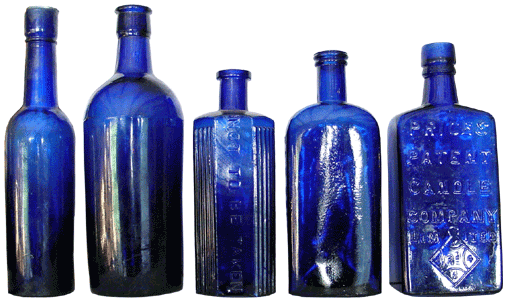
|
||||
| Blue glass was used almost exclusively to package medicinal products. Whether you are a digger, collector or simply mildly interested, these bottles are irresistible. | ||||
| A | B | C | D | E |
| No dig is successful nor collection complete without the most well know of all "blue bottles", the castor oil. | A fairly mundane chemists bottle with no embossing or outstanding features. | A more unusual octagonal chemists bottle embossed "not to be taken". This is an 8oz example, one of a series of 12 different sizes. | THE MEXICAN HAIR RENEWER, scarce, attractive, unusual and desirable. The embossing is on the sides. Note the unique double lip top. | In my opinion, the most desirable of all blue bottles... Prices Patent Candle Company Limited. This one embossed 1227 on base and bearing the diamond registration mark. |
| ~ Bovril ~ | ||||
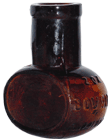 |
Click here |  |
 |
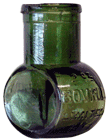 |
| Bovril was probably the most widely used meat extract in Victorian times and is still very popular. | ||||
| A | B | C | D | E |
| 2oz Bovril The most commonly found size of 6 different available sizes. |
16oz Bottle. The "catering" pack. Rather scarce and very attractive. |
1/2oz Bottle Problably a free sample. Very rare. How did they use all of it? |
Show-card Bottle. A half bottle stuck on to a cardboard advertising card. Extremely Scarce. |
2oz Green Glass Bovril. Embossed 214 on side and H G Co on bottom. 1 of only 2 known S.A. examples. |
| ~ Chemists Bottles (Cobalt Blue) ~ | ||||
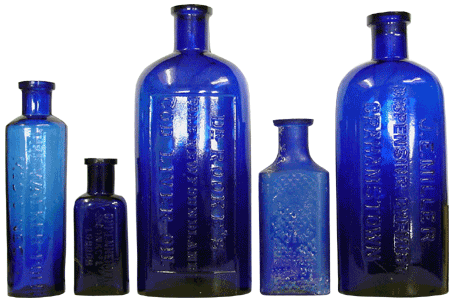 |
||||
| To find any blue glass bottle embossed with a product or owners name is unusual, making all of the examples above scarce... however some are scarcer than others. | ||||
| A | B | C | D | E |
| The Walker-Pol Medicine Co. Embossed 3oz on bottom . | Oppenheimer Son & Co Ltd. London. A 1oz size bottle. | Dr Rooke's Pale Newfoundland Cod Liver Oil. A large and crisply embossed bottle. | J.W. Mc Beath Kimberley Poison. One of very few South African Blue Chemists Bottles. Available in 3 sizes, smallest one pictured. | J.E. Miller Dispensing Chemist. Grahamstown. Only 3 known examples. I went to school in Grahamstown but do not recall this chemist. |
| ~ Codds ~ | ||||
 |
 |
 |
 |
 |
| Coloured lip and full colour body Codds are amongst the rarest and most sought after of all S.A. dug bottles. No coloured lip hybrid Codd has yet been auctioned in the U.K. | ||||
| A | B | C | D | E |
| This is a standard straight sided Codd with no particular enhancing features. Condition and Factory (logo) could influence value. | De Hoop Mineral Waters Pretoria with dark green marble in fair condition. Marbles come in a variety of colours, each unique to the factory. | Hamilton or "egg-ended" Codds are relatively scarce and the presence of a lime green coloured marble makes this bottle of Matthysen, Pretoria even more so. | S.A.'s most famous coloured lip Codd. A cellar-found Eugene S. Whyte Cradock (1892) Reliance patent. Highly prized by overseas collectors. | One of only 4 known coloured S.A. Codds. The other 3 being from the Shilling Factory Kimberley and A.T. Chambers East London. |
| ~ Cordials ~ | ||||
 |
 |
 |
 |
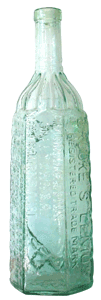 |
| The earlist Cordials (or as we know them today fruit juices) were derivatives of lime juice used extensively in the British Royal Navy from 1867. Roses Lime Juice bottles are always found in British Boer War dumps. | ||||
| A | B | C | D | E |
| Roses Lime Juice bottles are sure to be found in most early dumps especially where British soldiers camped during the Boer War. | Doble's Cordial was one of a number of Roses "look alike" products capitalising on the success of the real item. | Brooke's "Lemos" still going strong in S.A. today, unfortunately in a cheap and nasty plastic container but still a really refreshing drink. | Jessop's Royal Brand Export Lime Juice Cordial Lemon Squash prepared from the fresh fruit Jessop & Co London. | Sullivan's Fruit Juices Kimberley. An extremely rare specimen with unusual neck ribbing similiar O.T. Ltd Cordial. |
| ~ Dolls Heads ~ | ||||
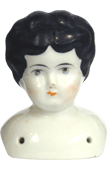 |
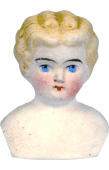 |
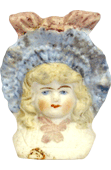 |
 |
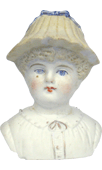 |
| These attractive remnants from by-gone times are highly collectable and are all rather scarce. | ||||
| A | B | C | D | E |
| This china dolls head known as a "Black Bertha" is common simply because it is more hardy than the Parian type. | Known as a "Blonde Bertha" this dolls head is 4 times scarcer than the Black Bertha. | Bonnet dolls are seldom found. Each one was hand crafted and painted and they are, in effect, miniature sculptures. | This is a Pin-cushion Doll, also known as a powder-puff doll. Highly collectable and very scarce. Beware of imitations! | This dolls head taken from a lesser known Kimberley dump is c .1885 and appears almost Afrikana in the form of the Kappetjie. |
| ~ Dwarf Inks ~ | ||||
 |
||||
| Even the ubiqitous dwarf ink has scarcer cousins, some of which are one-of-a-kind. | ||||
| A | B | C | D | E |
| Plain standard common Dwarf Ink | Scarcer white glazed version. | A large size salt glazed Dwarf Ink | A scarce Doulton Lambeth internally glazed ink with pouring lip. | An extremely old and rare crudely finished and roughly glazed ink. |
| ~ Fruit Salts ~ | ||||
 |
Picture to follow |  |
 |
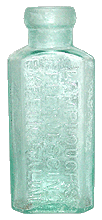 |
| From the earliest of Victorian times Fruit Salts were used as an antacid | ||||
| A | B | C | D | E |
| The most commonly found Fruit Salts bottle. Eno's has been available since the early 1890's. | A less common ice-blue Eno's Fruit Salt. | Salt Regal / The King of Effervescents. An obvious fore-runner of Eno's. | Salt Regal / The King of Effervescents. A smaller and even earlier version. | Lamploughs / Effervescing / Pyretic Saline. This bottle must be a good few years older than the (A) Eno's but note the similiar shape. |
| ~ Ginger Beers ~ | ||||
 |
 |
 |
 |
 |
| Ginger Beers are rated on their rarity and pictorial attractiveness | ||||
| A | B | C | D | E |
| This is S.A.'s most common ginger-beer bottle (SAGI = South African Garrison Institute). Probably the most affordable piece of Boer War memorabilia available. | This attractive bottle is common but still desirable due to its animal logo. | Although from the same factory, this bottle is much scarcer than the previous bottle. | Similar to no's 466 & 467 there are few known examples of this particular bottle. | This Maryvale Mineral Water Works is one of only 2 known examples. |
| ~ Ginger Pots ~ | ||||
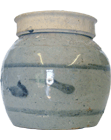 |
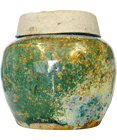 |
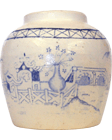 |
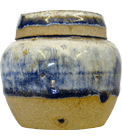 |
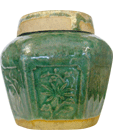 |
| From as small as 80mm to 160mm ginger pots are fascinating and each one uniquely different to the next. | ||||
| A | B | C | D | E |
| Plain, common and not particularly attractive. Used to store and dispense root ginger, imported from China. The lid was usually fired in-situ in the kiln. | A less common green glazed pot with matching lid. | A less common green glazed pot with matching lid. | A scarce blue dipped-glazed pot with matching lid. | A rare six sided pictorial paneled ginger pot with partially glazed lid. |
| ~ Inks (Cobalt Blue) ~ | ||||
 |
||||
| Cobalt Blue Inks are all rare and should all be rated D or E! In 20 years of digging I have only come across 3. All of those pictured above are locally dug. The rarity scale does not apply here. | ||||
| A | B | C | D | E |
| Blue Boat Ink. Has crisper lines and higher neck than its aqua glass counterpart. | Octagonal sheared lip Blue Ink. | Crude square 2 piece mould Ink with champhered sides and corners. | Round 2 piece mould sheared lip Ink. | "Pridge" shaped Ink with no embossing. Sheared lip, 2 piece mould. |
| ~ Inks (Locally Dug) ~ | ||||
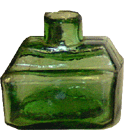 |
 |
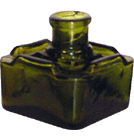 |
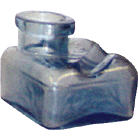 |
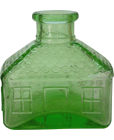 |
| Boat Inks are amongst the most commonly dug bottles but certain glass inks can be extremely rare and desirable. | ||||
| A | B | C | D | E |
| A dark coloured but not too unusual boat ink | An embossed Blackwood & Co London octagonal ink. | An unusual green glass ink with 4 way pen rests. | A "Polygon" ice blue ink with RD no. 676769 embossed on base. | An S.A. dug "Cottage" Ink. Although a later machine made bottle, the only recorded example of a locally dug cottage ink. |
| ~ Lysol ~ | ||||
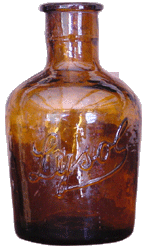 |
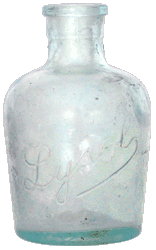 |
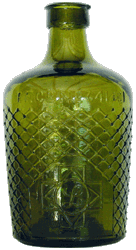 |
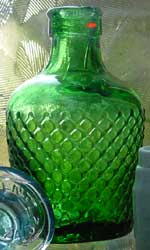 |
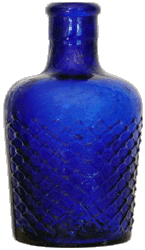 |
| A disinfectant liquid manufactured by Schulke & Mayr, Hamburg Germany. Most frequently found in small ( 90mm) attractive brown glass bottles but also seen in aqua, emerald green and cobalt blue. Most bottles bear the characteristic crosshatch raised ribbing as a warning against ingestion. | ||||
| A | B | C | D | E |
| Standard and common brown glass bottle. | Scarcer and earlier aqua glass with Lysol embossed on front and Makers Name and Trademark underneath. | Unuasually large (162 mm) dark green bottle with REGd No 641401 embossed on side and LYSOL Ltd London. No. 641401 on bottom. | Scarce Emerald Green Variety. | Rare Cobalt Blue Specimen with Crosshatch pattern and Reg. No. 641401 embossed on bottom. |
| ~ Magnesia (Cobalt Blue) ~ | ||||
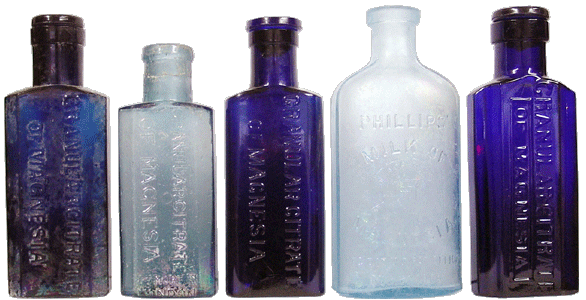 |
||||
| Granular Citrate of Magnesia was the fore-runner of Milk of Magnesia, an antacid and analgesic. | ||||
| A | B | C | D | E |
| A 6oz size fairly common magnesia bottle. Note bottles A,C & E have matching lids. | An old example embossed on the front at the bottom J.T. Morton London. | A slightly more modern 2 piece mould version. | Phillips' Milk of Magnesia Reg'd in U.S. Pat. Office Aug. 21. 1906. Note the absence of the screw top threads in this older bottle.. | A deep Cobalt Blue Granular Citrate of Magnesia bottle with unusual semi-circular champhered corners, embossed K1084 on bottom. |
| ~Medicine - Green Glass ~ | ||||
 |
 |
 |
 |
|
| Emerald green glass medicine / poisons are considerably scarcer than their cobalt blue counterparts. | ||||
| A | B | C | D | E |
| Embossed "Not to be taken". Found in 6 different sizes with capacity in Oz. Embossed on base | A triangular bottle with raised bumps to warn against mis-use in the dark. | Dr. Sheldon's / Magnetic Liniment. Embossed on sides Boston. U.S.A. / Cape Town. S.A. | A 4oz. Taylor Liverpool "Not to be taken" with Reg No 469210. Bought at U.K. bottle show. | |
| ~ Pickles / Chutney ~ | ||||
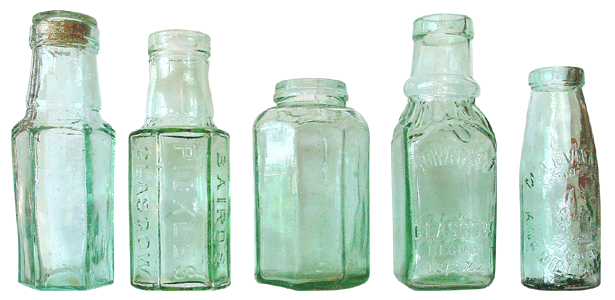 |
||||
| Pickles & Chutneys were extensively used at the turn of the century for both flavouring and preserving. | ||||
| A | B | C | D | E |
| A plain Boer War un-embossed Pickles bottle with matching glass top. | Baird's / Pickles / Glasgow. Slightly rarerer because of the embossing. | Pickles jars come in a variety of shapes and sizes usually six sided, sometimes square and occasionally octagonal | Rowat & Co Glasgow. Reg No 13/2762. An early and unusually shaped pickles bottle. | M.A. Evatt & Co Spring Buck Brand King Williams Town. An early South African pickles manufacturer. |
| ~ Poison - Cobalt Blue ~ | ||||
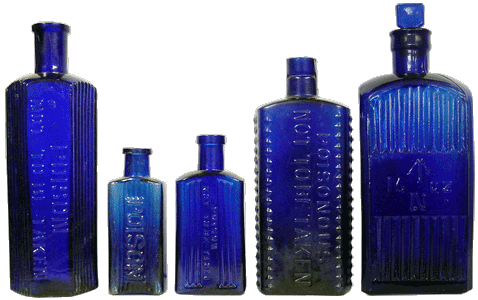 |
||||
| South African diggers / collectors are not likely to encounter such desirable poisons as skull and submarine, however there is still an interesting variety to be found locally. | ||||
| A | B | C | D | E |
| An 8oz version of the traditional six sided bottle with the word poison embossed. | A small (1oz) bottle simply embossed POISON. | An unusual tapering bottle embossed poison not to be taken. | Poisonous Not To Be Taken, 6oz size with ground top and hob nails. Embossed Rd No 590540. | An Admiralty Poison 16oz size with matching ground glass stopper.See p40 of ABC Issue 19 |
| ~ Poison - Green Glass ~ | ||||
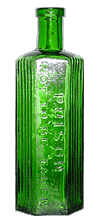 |
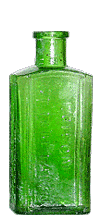 |
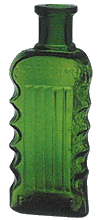 |
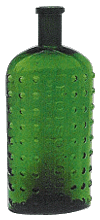 |
 |
| Green glass bottles embossed "Poison" are far scarcer than their cobalt-blue cousins. | ||||
| A | B | C | D | E |
| POISON / NOT TO BE TAKEN. The fact that this bottle is marked 6oz on base indicates that it is available in 11 different sizes from 1/2oz to 16oz. |
POISON / NOT TO BE TAKEN. A 2oz size. Although fairly plain, an extremely rare bottle. |
Wilson's Patent Poison. A scarce and desirable bottle |
POISONOUS / NOT TO BE TAKEN. A very rare bottle seldom seen. |
Only three or four of these Gilbertsons wedge poison bottles have been dug in South Africa. Embossed REGd - 30th - OCT - 1861. |
| ~ Snuff Bottles (Cobalt Blue)~ | ||||
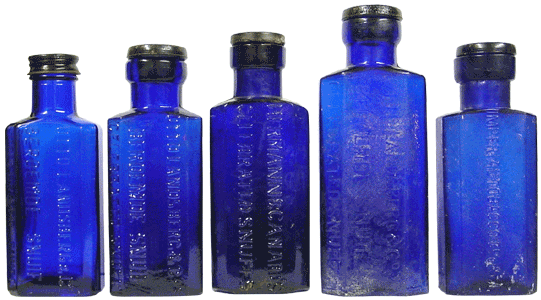 |
||||
| The medicinal value of Snuff was well understood by our forefathers. | ||||
| A | B | C | D | E |
| A more recent version of Otto Landsberg & Co Beroemde Snuif / Celebrated Snuff. Cape Town. Until recently, still available. | An older version of bottle A with matching top, note the applied wide mouth lip. | Hermann & Canard's Celebrated Snuffs. | "Otto Landsberg & Co's Beroemde Snuif / Celebrated Snuff. Cape Town". The earliest (and larger than B) version. 3 piece mould. | Imperial Tobacco Co of S.A. embossed .4460. on bottom. One of very few recorded S.A. Snuff bottles other than Otto Landsberg. |
| ~ Worcestershire Sauce ~ | ||||
 |
 |
 |
 |
 |
| On your next dig or antique fair forage, do not overlook the Worcestshire Sauce bottle. | ||||
| A | B | C | D | E |
| The ubiquitous Holbrook & Co. Worchestershire Sauce was widely used at the turn of the last century. | Yorkshire Relish / Goodall Backhouse & Co. A similiar bottle to A but much scarcer. | The Goldfields Sauce. A rare early Worcestershire sauce clearly specially made for the S.A. market. Embossed underneath 8521. | Hayward South African Sauce. Embossed TBH on the bottom. Thrown away c 1885. Extremely scarce.. | Holbrook & Co. A burst lip bottle with the characteristic glass stopper top and embossed "Jukes Bros / Patent / Birmingham" Thrown Away c 1875 |